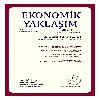Para Krizi Modellerine İlişkin Bir Değerlendirme
An Evaluation of the Currency Crises Models
___
- Agenor, Richard ve Robert Flood (1994), "Macroeconomic Policy, Speculative Attacks and Balance of Payments Crises", The Handbook of International Macroeconomics'in içinde, edit.Frederich Van Der Ploeg, Bölüm 8, Cambridge, Blackwell, s. 224-244.
- Aziz, Jahangir, Francesco Caramazza ve Ranil Salgado (2000), "Currency Crises: In Search of Common Elements" IMF Working Paper, No:00/67, s. 1-55.
- Chang, Roberto ve Andres Velasco (1998), "The Asian Liquidity Crisis", NBER Working Paper, No:6796, s.1-59.
- Çolak, Ö. Faruk, Hakan Ardor ve Mengü Tuncay (2001), "Finansal Kriz ve Bankalar: Türkiye'de 2000 ve 2001 Krizleri Örneği", Yeni Türkiye Dergisi, Sayı 41,s.701-711.
- Diamond, Douglas W. ve Philip H. Dybvig (1983), "Bank Runs, Deposit Insurance, and Liquidity", Journal of Political Economy, Vol:9I/3, s. 401-419.
- Drazen, Allan (1998), "Political Contagion in Currency Crises", NBER Conference on Currency Crises, Şubat 6-7, s. 1-31.
- Eren, Aslan ve Bora Süslü (2001) "Finansal Kriz Teorileri Işığında Türkiye'de Yaşanan Krizlerin Genel Bir Değerlendirmesi", Yeni Türkiye Dergisi, Sayı 41, s. 662-674.
- Flood, Robert ve Nancy P. Marion (1998), "Perspectives on the Recent Currency Crises Literature", IMF Working Paper, No:98/130, s.1-51.
- Flood, Robert ve Olivier Jeanne (2000), "An Interest Rate Defense of a Fixed Exchange Rate?", IMF, Research Dept. Draft, Mart, s.1-16.
- Flood, Robert ve Peter M. Garber (1981), " A Systematic Banking Collapse in a Perfect Foresight World", NBER Working Paper, No:691, s.1-41.
- Flood, Robert ve Peter M. Garber (1984), "Collapsing Exchange-Rate Regimes: Some Linear Examples", Journal of International Economics, No:17, s.1-13.
- Jeanne, Olivier (1997), "Are Currency Crises Self-Fulfilling? A Test", Journal of International Economics, No:43, s.263-286.
- Ickes, W. Barry (2004), "Lecture Note On Crises", http://econ.la.psu.edu/~bickes/crisesl.pdf, s. 1-32.
- Krugman, Paul (1979), "A Model of Balance-of-Payments Crises", Journal of Money, Credit and Banking, Vol: 11, No:3, s.310-325.
- Krugman, Paul (1999), "Balance Sheets, The Transfer Problem, And Financial Crises", Paper For the Festschrift Volume in Honour of Robert Flood, January.
- Krugman, Paul (2002), "Analytical Afterthoughts on the Asian Crisis", Manuscript, http://web.mit.edu/krugman/www/minicris.htm, s. 1-7.
- Marion, Nancy (1999), "Some Parallels Between Currency and Banking Crises", International Tax and Public Finance, No:6, s.473-490.
- Masson, Paul (1998), "Contagion: Monsoonal Effects, Spillovers and Jumps Between Multiple Equilibria", IMF Working Paper, No: 142, s.1-32.
- Mishkin, S. Frederic (1999), "Global Financial Instability: Framework, Events, Issues", Journal of Economic Perspectives, Volume: 13, No:4, s. 3-20.
- Obstfeld, Maurice (1996), "Models of Currency Crises with Self-Fulfilling Features", European Economic Review, No:40, s. 1037-1047.
- Önder, İzzettin (2001), "Ekonomik Kriz", Yeni Türkiye Dergisi, Sayı 41, s. 45-55.
- Özatay, Fatih ve Güven Sak (2002), "Banking Sector Fragility and Turkey's 2000-01 Financial Crisis", Brookings Trade Forum, Editors: Dani Rodrik, Susan M. Collins, Brookings Institution Press, Washington, s.121-172.
- Radalet, Steven ve Jeffrey Sachs (1998), "The Onset of the East Asian Financial Crises", NBER Working Paper, No:6680, s.1-74.
- Salant, Stephen ve Dale Henderson (1978), "Market Anticipation of Goverment Policy and the Price of Gold", Journal of Political Economy, No:86, s.627-648.
- Varlık, Cemil (2002), "İkiz Krizler: Para Krizleri İle Bankacılık Krizleri Arasındaki Bağlantılar", Ekonomik Yaklaşım Dergisi, cilt: 13, sayı:42-43, s.159-180.
- Walti, Sebastien (2003), "Simple Models of Currency Crises", http://signe.krogstrup.com/IE/Archive/Walti2003.pdf, s. 1-17.
- Yay, G. Gülsün (2001), "1990'lı Yıllardaki Finansal Krizler ve Türkiye Krizi", Yeni Türkiye Dergisi, Sayı:42, s.1234-1248.
- ISSN: 1300-1868
- Yayın Aralığı: 3
- Yayıncı: Ekonomik Yaklaşım Derneği
Suç Sanayinin Alanı İnsan Ticareti: Türkiye Açısından Bir Değerlendirme
Hakan Naim ARDOR, Fahriye ÖZTÜRK
Türkiye Bankacılık Sektörü İçin Alternatif Bir Risk Derecelendirme Modeli
Daraltıcı Devalüasyon Hipotezi: Türkiye Üzerine Bir Uygulama
Poliklinik ve Ameliyat Hizmeti Veren Hastanelerin Sahiplarine Bağlı Olarak Oluşan Refah Kayıpları
Filiz YEŞİLYURT, M. Ensar YEŞİLYURT
